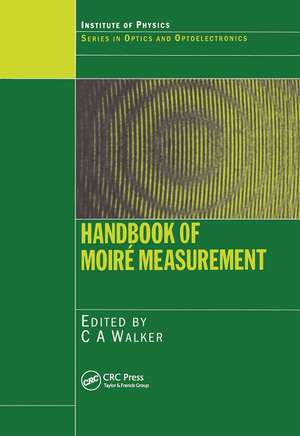Handbook of Moire Measurement
Editat de C.A. Walkeren Limba Engleză Paperback – 26 noi 2019
Preț: 498.93 lei
Preț vechi: 586.97 lei
-15% Nou
Puncte Express: 748
Preț estimativ în valută:
95.47€ • 102.09$ • 79.60£
95.47€ • 102.09$ • 79.60£
Carte tipărită la comandă
Livrare economică 18 aprilie-02 mai
Preluare comenzi: 021 569.72.76
Specificații
ISBN-13: 9780367454425
ISBN-10: 0367454424
Pagini: 501
Dimensiuni: 156 x 234 x 27 mm
Greutate: 0.72 kg
Ediția:1
Editura: CRC Press
Colecția CRC Press
ISBN-10: 0367454424
Pagini: 501
Dimensiuni: 156 x 234 x 27 mm
Greutate: 0.72 kg
Ediția:1
Editura: CRC Press
Colecția CRC Press
Public țintă
Academic and Professional Practice & DevelopmentCuprins
1 Introduction, 1.1 A brief history of the moiré method, References, CHAPTER 2: STRAIN MEASUREMENTS AT THE LIMIT—THE MOIRÉ MICROSCOPE, 2.1 Nonlinear analysis of interferometric moiré fringes, 2.1.1 Example fringe data reduction, References, 2.2 Microscopic moiré interferometry, 2.2.1 Immersion interferometer, 2.2.1.1 Optical configuration, 2.2.1.2 Four-beam immersion interferometer, 2.2.2 Mechanical configuration, 2.2.3 Fringe shifting and O/DFM method, References, 2.3 Localized thermal strains in electronic interconnections by microscopic moiré interferometry, 2.3.1 Specimen preparation, 2.3.2 Thin small outline package, 2.3.3 Leadless chip carrier, 2.3.4 Effect of underfill encapsulation on flip chip solder bump, 2.3.5 Plated through hole, References, 2.4 Titanium in elastic tension: micromechanical deformation, 2.4.1 Introduction, 2.4.2 Specimen and loading fixture, 2.4.3 Experimental procedure and fringe patterns, 2.4.4 Anomalous strains along the grain boundaries, 2.4.5 Discussion, References, 2.5 Micromechanical thermal deformation of unidirectional boron/aluminum composite, 2.5.1 Experimental procedure and fringe patterns, 2.5.2 Analysis and results, 2.5.3 Discussion, References, CHAPTER 3: FRACTURE MECHANICS, 3.1.1 Assessment of the shape of crack-tip plastic zones as a function of applied load, 3.1.1.1 Introduction, 3.1.1.2 Experimental details, 3.1.1.3 Measurement of Von Mises yield locus, 3.1.1.4 Discussion of results, 3.1.1.5 Conclusions, References, 3.1.2 Deformation around fatigue cracks from moiré fringe measurement, 3.1.2.1 Introduction, 3.1.2.2 Basic crack-tip models, 3.1.2.2.1 Stationary crack under monotonie loading, 3.1.2.2.2 Stationary crack under cyclic loading, 3.1.2.3 Experimental details, 3.1.2.4 Fatigue crack-tip deformation, 3.1.2.4.1 Local yielding, 3.1.2.4.2 Non-singular stresses, 3.1.2.4.3 Cyclic plasticity, 3.1.2.4.4 Local mode-mixity, 3.1.2.5 Summary, Acknowledgment, References, 3.2.1 Applications of moiré to cellulosic (paper and woo
Notă biografică
CA Walker Department of Mechanical Engineering, University of Strathclyde, UK
Descriere
Since its development in the late 1970s, the Moiré Fringe method has become a standard technique for measuring the behavior of materials and structures. Edited by one of the technique's co-inventors, this book brings together extended case studies from experts in the field. Emphasizing applications to real situations, the book presents a very reada
